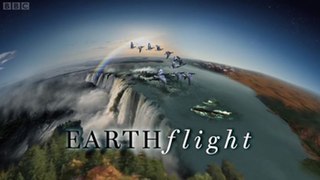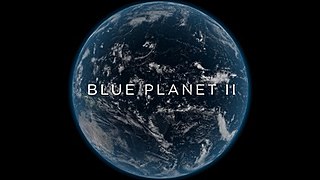
The Blue Planet is a British nature documentary series created and produced by the BBC. It premiered on 12 September 2001 in the United Kingdom. It is narrated by David Attenborough.
Torchwood is a British science fiction television programme created by Russell T Davies. A spin-off of the 2005 revival of Doctor Who, it aired from 2006 to 2011. The show shifted its broadcast channel each series to reflect its growing audience, moving from BBC Three to BBC Two to BBC One, and acquiring American financing in its fourth series when it became a co-production of BBC One and Starz. Torchwood is aimed at adults and older teenagers, in contrast to Doctor Who's target audience of both adults and children. As well as science fiction, the show explores a number of themes, including existentialism, LGBTQ+ sexuality, and human corruptibility.

Planet Earth is a 2006 British television series produced by the BBC Natural History Unit. Five years in the making, it was the most expensive nature documentary series ever commissioned by the BBC and also the first to be filmed in high definition. The series received multiple awards, including four Emmy Awards, a Peabody Award, and an award from the Royal Television Society.

Galápagos is a three-part BBC nature documentary series exploring the natural history of the Galápagos Islands and their important role in the formation of Charles Darwin's theory of evolution. It was first transmitted in the UK on BBC Two in September 2006.
This is a chronological list of selected television programmes and feature films produced or co-produced by the BBC Studios Natural History Unit since its inception in 1957. It is not intended to be exhaustive given the large amount of material the Unit has produced in its history, but it does capture all the major TV series and films for which it has gained recognition. A brief synopsis of pre-1957 radio and television programmes on a natural history theme made by the BBC is given in the History section of the main BBC Studios Natural History Unit article.

Earth is a 2007 nature wildlife documentary film which depicts the diversity of wild habitats and creatures across the planet. The film begins in the Arctic in January of one year and moves southward, concluding in Antarctica in the December of the same year. Along the way, it features the journeys made by three particular species—the polar bear, African bush elephant and humpback whale—to highlight the threats to their survival in the face of rapid environmental change. A companion piece and a sequel to the 2006 BBC/Discovery television series Planet Earth, the film uses many of the same sequences, though most are edited differently, and features previously unseen footage not seen on TV.

Wild China is a six-part nature documentary series on the natural history of China, co-produced by the BBC Natural History Unit and China Central Television (CCTV) and filmed in high-definition (HD). It was screened in the UK on BBC Two from 11 May to 5 June 2008. The English narration was provided by Bernard Hill and the series produced by Phil Chapman for the BBC and Gao Xiaoping for CCTV. The Chinese version was broadcast under the title Beautiful China. In Canada, it was broadcast on CBC as part of the series The Nature of Things narrated by David Suzuki. Wild China was broadcast in Australia on ABC1 and ABC HD each Sunday at 7:30pm from 18 May 2008.

Frozen Planet is a 2011 British nature documentary series, co-produced by the BBC and The Open University. It was filmed by the BBC Natural History Unit. The production team, which includes executive producer Alastair Fothergill and series producer Vanessa Berlowitz, were previously responsible for the award-winning series The Blue Planet (2001) and Planet Earth (2006), and Frozen Planet is billed as a sequel of sorts. David Attenborough returns as narrator. It is distributed under licence by the BBC in other countries, Discovery Channel for North America, ZDF for Germany, Antena 3 for Spain and Skai TV for Greece.

William Goodchild is a composer, orchestrator and conductor who produces music for film, television and the concert hall.

Life is a British nature documentary series created and produced by the BBC in association with The Open University. It was first broadcast as part of the BBC's Darwin Season on BBC One and BBC HD from October to December 2009. The series takes a global view of the specialised strategies and extreme behaviour that living things have developed in order to survive; what Charles Darwin termed "the struggle for existence". Four years in the making, the series was shot entirely in high definition.

Human Planet is an 8-part British television documentary series. It is produced by the BBC with co-production from Discovery and BBC Worldwide. It describes the human species and its relationship with the natural world by showing the remarkable ways humans have adapted to life in every environment on Earth. The show drew attention for alleged fakery and the BBC eventually acknowledged that a number of scenes were inaccurately depicted or misleading and withdrew the series from distribution.

The seventh series of the British science fiction television programme Doctor Who was broadcast concurrently on BBC One in the United Kingdom, and was split into two parts as the previous series had been. Following its premiere on 1 September 2012, the series aired weekly with five episodes until 29 September. The remaining eight episodes were broadcast between 30 March and 18 May 2013. The 2012 Christmas special, "The Snowmen", aired separately from the main series and introduced a new TARDIS interior, title sequence, theme tune, and outfit for the Doctor.

Earthflight is a British nature documentary that shows a flight from the view of the wings of birds across six continents, showing some of the world's greatest natural spectacles from a bird's-eye view. The BBC series was created by John Downer and narrated by David Tennant and consisted of six 60-minute episodes. The first episode aired on BBC One on 29 December 2011.

The Musketeers is a British period action-drama program based on the characters from Alexandre Dumas's 1844 novel The Three Musketeers and co-produced by BBC America and BBC Worldwide. The series follows the musketeers Athos, Aramis, and Porthos as they serve King Louis XIII and citizens of 17th-century Paris. The first episode was shown on BBC One on 19 January 2014. It stars Tom Burke as Athos, Santiago Cabrera as Aramis, Howard Charles as Porthos, Luke Pasqualino as D'Artagnan, Tamla Kari as Constance Bonacieux, Maimie McCoy as Milady de Winter, Ryan Gage as Louis XIII and Alexandra Dowling as Queen Anne. It also features Peter Capaldi as Cardinal Richelieu in Series One, Marc Warren as Comte de Rochefort in Series Two, and Rupert Everett as the Marquis de Feron in Series Three.

Hidden Kingdoms is a British documentary television series that was first broadcast on BBC One on 16 January 2014. The three-part series is narrated by Stephen Fry and shows how animals experience the world from their perspective. Animals shown include a chipmunk, dung beetle, Rufous elephant shrew and treeshrew, and Japanese rhinoceros beetle.

Life Story is a British natural-history television series with Mike Gunton, Rupert Barrington and Tom Hugh-Jones from the BBC Natural History Unit on the production team. The six-part series reveals the challenges faced by individual animals at different stages of their lives and was first broadcast on BBC One in 2014. The series is introduced and narrated by David Attenborough.

The Hunt is a 2015 British nature documentary series made for BBC Television, first shown in the UK on BBC One and BBC One HD on 1 November 2015. The series is narrated by David Attenborough.

Planet Earth II is a 2016 British nature documentary series produced by the BBC as a sequel to Planet Earth, which was broadcast in 2006. The series is presented and narrated by Sir David Attenborough with the main theme music composed by Hans Zimmer.
Spy in the Wild is a British nature documentary television series, produced by BBC Natural History Unit, John Downer Productions and PBS. The series, which is directed and produced by John Downer, premiered in 2017 with a second series in 2020. The employment of animatronics makes it possible to document interactive behaviour no animal would have shown towards a human filmmaker or in front of a hidden camera.

Blue Planet II is a 2017 British nature documentary series on marine life produced by the BBC Natural History Unit. Like its predecessor, The Blue Planet (2001), it is narrated and presented by naturalist Sir David Attenborough.



















